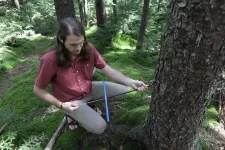(Press-News.org) ITHACA, N.Y. - Soft robots may not be in touch with human feelings, but they are getting better at feeling human touch.
Cornell University researchers have created a low-cost method for soft, deformable robots to detect a range of physical interactions, from pats to punches to hugs, without relying on touch at all. Instead, a USB camera located inside the robot captures the shadow movements of hand gestures on the robot's skin and classifies them with machine-learning software.
The group's paper, "ShadowSense: Detecting Human Touch in a Social Robot Using Shadow Image Classification," published in the Proceedings of the Association for Computing Machinery on Interactive, Mobile, Wearable and Ubiquitous Technologies. The paper's lead author is doctoral student, Yuhan Hu.
The new ShadowSense technology is the latest project from the Human-Robot Collaboration and Companionship Lab, led by the paper's senior author, Guy Hoffman, associate professor in the Sibley School of Mechanical and Aerospace Engineering.
The technology originated as part of an effort to develop inflatable robots that could guide people to safety during emergency evacuations. Such a robot would need to be able to communicate with humans in extreme conditions and environments. Imagine a robot physically leading someone down a noisy, smoke-filled corridor by detecting the pressure of the person's hand.
Rather than installing a large number of contact sensors - which would add weight and complex wiring to the robot, and would be difficult to embed in a deforming skin - the team took a counterintuitive approach. In order to gauge touch, they looked to sight.
"By placing a camera inside the robot, we can infer how the person is touching it and what the person's intent is just by looking at the shadow images," Hu said. "We think there is interesting potential there, because there are lots of social robots that are not able to detect touch gestures."
The prototype robot consists of a soft inflatable bladder of nylon skin stretched around a cylindrical skeleton, roughly four feet in height, that is mounted on a mobile base. Under the robot's skin is a USB camera, which connects to a laptop. The researchers developed a neural-network-based algorithm that uses previously recorded training data to distinguish between six touch gestures - touching with a palm, punching, touching with two hands, hugging, pointing and not touching at all - with an accuracy of 87.5 to 96%, depending on the lighting.
The robot can be programmed to respond to certain touches and gestures, such as rolling away or issuing a message through a loudspeaker. And the robot's skin has the potential to be turned into an interactive screen.
By collecting enough data, a robot could be trained to recognize an even wider vocabulary of interactions, custom-tailored to fit the robot's task, Hu said.
The robot doesn't even have to be a robot. ShadowSense technology can be incorporated into other materials, such as balloons, turning them into touch-sensitive devices.
In addition to providing a simple solution to a complicated technical challenge, and making robots more user-friendly to boot, ShadowSense offers a comfort that is increasingly rare in these high-tech times: privacy.
"If the robot can only see you in the form of your shadow, it can detect what you're doing without taking high fidelity images of your appearance," Hu said. "That gives you a physical filter and protection, and provides psychological comfort."
INFORMATION:
The research was supported by the National Science Foundation's National Robotic Initiative.
URBANA, Ill. - From flooded spring fields to summer hailstorms and drought, farmers are well aware the weather is changing. It often means spring planting can't happen on time or has to happen twice to make up for catastrophic losses of young seedlings.
According to a joint study between University of Illinois and USDA-ARS, it also means common pre-emergence herbicides are less effective. With less weed control at the beginning of the season, farmers are forced to rely more heavily on post-emergence herbicides or risk yield loss.
"We're having more variable precipitation, including conditions where folks aren't able to plant because fields are too wet. In those cases, pre-emergence herbicide applications are getting pushed back into a period that is consistently drier," ...
Colorectal cancer screening rates jumped by more than 1,000 percent when researchers sent take-at-home tests to patients overdue for testing at a community health center that predominantly serves people of color. Instead of the oft-standard text message that simply reminds a patient that they are overdue for screening, researchers from the Perelman School of Medicine at the University of Pennsylvania made it the default to send a take-at-home test to the patient's home unless they opted out via a text message prompt. The research was published in the Journal of General Internal Medicine.
"Colorectal cancer screening rates remain limited ...
New research from West Virginia University biologists shows that trees around the world are consuming more carbon dioxide than previously reported, making forests even more important in regulating the Earth's atmosphere and forever shift how we think about climate change.
In a study published in the Proceedings of the National Academy of Sciences, Professor Richard Thomas and alumnus Justin Mathias (BS Biology, '13 and Ph.D. Biology, '20) synthesized published tree ring studies. They found that increases in carbon dioxide in the atmosphere over the past century have caused ...
A new study suggests that differences in the expression of gene transcripts - readouts copied from DNA that help maintain and build our cells - may hold the key to understanding how mental disorders with shared genetic risk factors result in different patterns of onset, symptoms, course of illness, and treatment responses. Findings from the study, conducted by researchers at the National Institute of Mental Health (NIMH), part of the National Institutes of Health, appear in the journal Neuropsychopharmacology.
"Major mental disorders, such as schizophrenia, bipolar disorder, and major depressive disorder, share common genetic roots, but each disorder presents differently in each individual," said Francis J. McMahon, M.D., a senior author of the ...
PHILADELPHIA (February 8, 2021) - An abundance of data underscore the importance of breastfeeding and human milk for the optimal health of infants, children, mothers, and society. But while breastfeeding initiation rates have increased to more than 80% in the U.S., a disparity exists for African American mothers and infants. In this group, breastfeeding is initiated only about 69% of the time.
A new study to help identify the best strategies and practices to improve breastfeeding in the African American community leverages the opinions, knowledge, and experiences of subject matter exerts (SMEs) with national and international exposure to policies and practices influencing African ...
Wearable devices can identify COVID-19 cases earlier than traditional diagnostic methods and can help track and improve management of the disease, Mount Sinai researchers report in one of the first studies on the topic. The findings were published in the END ...
As human interaction with robots and artificial intelligence increases exponentially in areas like healthcare, manufacturing, transportation, space exploration, defense technologies, information about how humans and autonomous systems work within teams remains scarce.
Recent findings from human systems engineering research demonstrate that human-autonomy teaming comes with interaction limitations that can leave these teams less efficient than all-human teams.
Existing knowledge about teamwork primarily is based on human-to-human or human-to-automation interaction, which positions humans as supervisors of automated partners.
But as autonomy has increasingly ...
How did rocks rust on Earth and turn red? A Rutgers-led study has shed new light on the important phenomenon and will help address questions about the Late Triassic climate more than 200 million years ago, when greenhouse gas levels were high enough to be a model for what our planet may be like in the future.
"All of the red color we see in New Jersey rocks and in the American Southwest is due to the natural mineral hematite," said lead author Christopher J. Lepre, an assistant teaching professor in the Department of Earth and Planetary Sciences in the School of Arts and Sciences at Rutgers University-New Brunswick. ...
How come we don't hear everything twice: After all, our ears sit on opposite sides of our head and most sounds do not reach both our ears at exactly the same time. "While this helps us determine which direction sounds are coming from, it also means that our brain has to combine the information from both ears. Otherwise, we would hear an echo," explains Basil Preisig of the Department of Psychology at the University of Zurich.
In addition, input from the right ear reaches the left brain hemisphere first, while input from the left ear reaches the right brain hemisphere first. The two hemispheres ...
Louisiana State University College of the Coast & Environment Boyd Professor R. Eugene Turner reconstructed a 100-year record chronicling water quality trends in the lower Mississippi River by compiling water quality data collected from 1901 to 2019 by federal and state agencies as well as the New Orleans Sewerage and Water Board. The Mississippi River is the largest river in North America with about 30 million people living within its watershed. Turner focused on data that tracked the water's acidity through pH levels and concentrations of bacteria, oxygen, lead and sulphate in this study published in Ambio, a journal of the Royal Swedish Academy of Sciences.
Rivers ...



